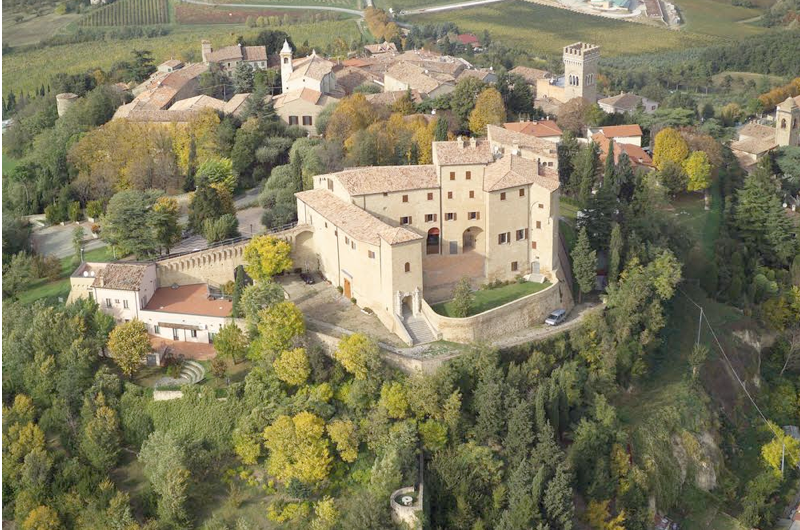Introduction
September 9 to 13, 2018, the fourth annual DEIS-sponsored Summer School on Dielectric Interfaces was held in Bertinoro, Italy. The objectives of the summer school are to organize brainstorms of challenging topics in the field of dielectrics and electrical insulation among young researchers, discuss research methodology, support the creation of research networks, and stimulate subsequent activities, including joint research work, presentations, and special sessions at DEIS conferences. The summer school was open to PhD students and early-career PhDs. There were 15 participants and four moderators forming an international gathering from Italy, the UK, France, Germany, China, the Netherlands, the United States, and Japan. The summer school was led by Alun Vaughan, John Fothergill, Peter Morshuis, and Thomas Andritsch.
The advertised topics of the summer school were interfacial phenomena at the nanoscale, heat transport in solid dielectrics, and objective measurements of nanodielectrics, including the size of interfacial/interphase zones and dispersion and distribution of nanoparticles. A common theme was the fundamental examination of the interphase region between nanoparticles and the matrix polymer. The questions that were considered included whether the interphase truly existed; what the size, location, and properties of the interphase are; and whether the interphase can explain the significant changes in the bulk properties of nanocomposites.
The summer school was centered around group discussions and collaborative work, with some introductory presentations on the nanoscale and nanocomposites, the interface and interphase effects, and heat transport in nanocomposites. Throughout the four days of the summer school, fundamental questions on the effects of nanoparticles in polymeric materials were discussed, and very interesting ideas were brainstormed. Moreover, the supervisors led the participants through the principles of designing a SMART (Specific, Measurable, Attainable, Relevant, and Timely) research question and the fundamental requirements for a good research proposal. Then three groups were formed, each with the task of developing a SMART research question and a research plan. The group members started by introducing themselves and their areas of expertise before discussing the ideas presented to the full group and finding a suitable research question. Over the course of the next few days, the groups regularly received input and guidance from the supervisors, while they developed the research question from a very basic idea to a project that is well developed and feasible. The following summaries describe the work of each of the groups.

Group A
Group A focused its efforts on the question of whether the presence of the interphase region could be measured directly. Previously proposed models of the interphase claim that the dispersion of nanoparticles within the polymer will alter the properties of the polymer within the interphase region surrounding each particle. If this model is accurate, it should be possible in a properly designed experiment to see evidence of the interphase region due to its different properties from the nanoparticles and bulk polymer. Thus, group A narrowed its focus to design a model system and experiments that could measure direct evidence of an interphase region. Specifically, if the interphase is primarily a region of polymer that has an altered crystallinity from the bulk polymer due to the presence of or binding to the nanoparticle, or both, this interphase could be detected by examining the crystallinity of the nanocomposite.
In defining the research plan, differential scanning calorimetry (DSC) was chosen as the experimental method to measure the crystallinity of the polymer. In a time for feedback during presentation and discussion with all groups, Vaughan suggested using an alkane polymer matrix due to the availability of uniform chain lengths. Although an alkane matrix may not be ideal for many applications, the narrow melting peak of the bulk alkane in this model system is expected to provide the resolution required for a DSC measurement to identify the presence of an interphase with altered crystallinity. Silica nanoparticles were selected as the filler, though other nanoparticles could also be used in the proposed experiments. Nanocomposites will be prepared with both untreated silica and silica functionalized with a mono-alkoxy silane. A mono-alkoxy silane was selected to minimize binding between the molecules of the coupling agent bound to the surface of the nanoparticles. In addition to using treated and untreated particles, samples with two filler loading percentages will be made and tested.
The SMART research question that guided this development was stated as the following: “Do silica nanoparticles modified with coupling agents cause measurable differences in the crystallinity of an alkane matrix?” From this research question, the planned experiments are designed to test the following two hypotheses. First, if there is an interphase with altered crystallinity from the bulk alkane, the DSC measurements will show a modified peak from a sample of bulk alkane. Second, increasing the filler loading percentage will increase the magnitude of the new peak in the DSC curve.
The research plan was determined to be a realistic effort to further pursue as an international collaboration. The samples will be made at the University of Southampton in the UK, with other group members in Italy, China, and the United States performing round-robin DSC measurements and other project support. The group plans to prepare and submit a manuscript for publication of the details of the experimental methods and results.
Group B
The research question of the second group focused on how the surface functionality of nanoparticles and, therefore, the interaction between nanoparticles and the surrounding polymer matrix can influence the macroscopic material properties of a nanocomposite. To obtain a SMART research question, the starting idea was specified by choosing the polymer epoxy and silica nanoparticles with functional epoxy groups at the surface. The evaluation of the glass transition temperature by DSC measurements will provide information about the effect of the interactions between the nanoparticles and the epoxy on the thermal material properties. For this purpose, the density of the functional groups is varied. This allows the extent of the interactions to be influenced systematically and for the determination of their effect on the macroscopic material properties. This way the following research question was formulated: Can the density of functional epoxy groups on the surface of nanoparticles influence the glass transition temperature of epoxy polymer?
To find the answer to this question, it is planned to functionalize the surface of silica nanoparticles with different numbers of functional groups that can be used to react in a selective way with the polymer matrix to observe the effect on the glass transition temperature. The different steps of manufacturing the samples and the experiments can be carried out as a joint project at the different facilities (Southampton, Munich, Parma, Bologna, and Tokyo) where the students of this group come from. Further experiments besides the DSC such as infrared spectroscopy, transmission electron microscopy, thermogravimetric analysis, and dielectric spectroscopy can reveal important information about the nanocomposite itself and its material properties. The realization of this project includes research visits and short visits to update the project and to plan the next steps. In total this research project can be accomplished in two years.
Group C
At the summer school, this group was interested in the zone between a nanoparticle and the polymer in nanocomposites and wondered whether one could vary the interphase region without varying the interface. This developed into a SMART question: How does the length of molecules grafted to nanosilica affect the dielectric properties of polyethylene (PE)? This idea is illustrated in the diagram.

The reasoning behind this was that the molecules grafted to the surface of the nanosilica will in some way change the structure of the region between the nanoparticle and the PE. It was decided that using the complementary techniques of atomic force microscopy, the pulsed electroacoustic method, and dielectric spectroscopy would be sufficient to probe these structural changes. The atomic force microscopy would report on the local microscopic properties, and the other technique would focus on the macroscopic techniques. In this way, the aim was to achieve a good understanding of the mechanism causing the dielectric properties. Initially, one concentration of nanoparticles in the polymer matrix should be used before varying the concentration because this would also vary the volume of the structure affected by the grafted molecules. The point of varying the chain length would be to differ the amounts of the neighboring structure of the polymer matrix, although it is accepted that the length of the grafted molecular chain would not necessarily be equal to the amount of the PE affected.
While varying the chain length, the interface between the grafted molecules and PE, as well as the interface between the grafted molecules and the nanoparticle, is kept constant. The distance between these two interfaces corresponds to the length of the chain, and this, together with some of the PE affected by the grafted molecules, changes the interphase region. In this way, the interphase can be investigated while keeping the interface constant.
With regard to the synthesis of the nanosilica, it was decided that grafting the molecules to the silica in the laboratory will avoid size distribution discrepancies that may arise if pregrafted nanosilica were purchased. Another point of consideration would be to ensure that the dispersion of the nanofiller in the polymer matrix is consistent between the samples.
For this project it would require at least six months to realize the first concentration loading. Therefore, the whole project would require a substantial investment of time, which would be unreasonable to ask of a PhD candidate without official approval. As such, the best way to realize this project would either be the commencement of a new PhD project or for a supervisor to accept a recommendation of approval from the academic staff running the summer school as well as funding being made available to cover the costs of the work.
But It Wasn’t All Work!
Another key aspect of the summer school was to get to know and establish contacts with young researchers from other universities and companies all over the world. Developing such a network is an essential basis for successful research in this multidisciplinary field. The participants enjoyed the evenings getting to know the other scientists who are at a similar stage in their careers while enjoying some delicious Italian food. For this purpose, having the summer school in Bertinoro was ideal because it was far away from the distractions of a city. Moreover, hospitality toward foreigners has a very long tradition in Bertinoro. A contemporary witness is the Column of Hospitality, which was built at the beginning of the 13th century and is located in the city center. Each ring of the column belongs to a family in Bertinoro. When a visiting foreigner chose one of the rings by tying his horse to it, he would become a guest of that family. This hospitality still has a very high value in Bertinoro, and guests are welcomed warmly.

Furthermore, one afternoon there was a guided tour of Bertinoro. First, the group visited the castle Rocca at the conference center, which was first referred to in 995 and is home to the Interfaith Museum, dedicated to the three monotheistic religions Judaism, Christianity, and Islam. Afterward, the Bertinoro Cathedral was viewed, which is dedicated to Saint Catherine of Alexandria, before the guided tour finished with a visit to a local winery and some wine tasting.
What Comes Next…
Upon leaving the summer school, everyone was keen to keep the network active. The next goal is to work on two of the research plans developed at the summer school. The groups are excited to continue an international collaboration on the ideas developed through this event. Collectively, they have access to a wide range of laboratory equipment and resources, which pooled together puts them in a great position to achieve very interesting results. The participants of the summer school hope to strengthen their network over time and look forward to meeting each other again at the next international conference.
Acknowledgments
The authors extend their thanks again to Alun, Thomas, Peter, and John as well as the DEIS for their kind sponsorship to make such a significant event possible.
Kevin O’Connor, Annika-Sophie Rempe, and Allison Shaw (Representing the students of the 2018 DEIS Summer School)





